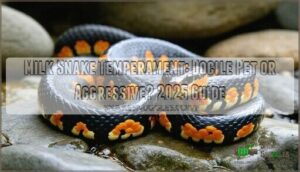This site is supported by our readers. We may earn a commission, at no cost to you, if you purchase through links.
 If you’re wondering about the temperament of a milk snake, you’re in for good news. These reptiles are incredibly docile and rarely show aggression unless they feel genuinely threatened. Their calm nature makes them perfect for beginners who want a snake that won’t constantly stress them out.
If you’re wondering about the temperament of a milk snake, you’re in for good news. These reptiles are incredibly docile and rarely show aggression unless they feel genuinely threatened. Their calm nature makes them perfect for beginners who want a snake that won’t constantly stress them out.
While juveniles might be a bit more defensive due to their size, adults usually develop a relaxed demeanor that makes handling feel almost straightforward. You’ll find they’re predictable creatures with consistent behavior patterns, unlike some species that can be moody or unpredictable.
Their gentle disposition, combined with their stunning appearance, explains why they’ve become such popular pets. The secret to their mellow personality lies in understanding what keeps them comfortable and stress-free.
Table Of Contents
- Key Takeaways
- Milk Snake Temperament Overview
- Behavioral Characteristics of Milk Snakes
- Handling and Taming Milk Snakes
- Housing and Environmental Impact on Mood
- Influence of Heat, Light, and Humidity
- Diet, Feeding, and Stress Reduction
- Choosing and Caring for a Milk Snake
- Frequently Asked Questions (FAQs)
- What is the typical lifespan of a milk snake?
- How big do milk snakes grow?
- Are milk snakes easy to breed and care for the eggs?
- What health issues are milk snakes prone to?
- Are milk snakes legal to own as pets in my state/country?
- Do milk snakes make good beginner pets?
- Can milk snakes recognize their owners?
- Are milk snakes active during day or night?
- Do milk snakes need companions or prefer solitude?
- How often do milk snakes shed skin?
- Conclusion
Key Takeaways
- You’ll find milk snakes are incredibly docile and rarely show aggression, making them perfect beginner pets with predictable, calm behavior patterns.
- Juveniles might be more defensive initially, but adults develop a relaxed temperament that makes handling straightforward once they’re properly acclimated.
- Your snake’s environment directly affects its mood – secure enclosures with proper temperature gradients, hiding spots, and consistent feeding schedules promote calm behavior.
- You can expect these snakes to become tolerant companions through regular, gentle handling sessions, as they respond well to consistent interaction and proper care.
Milk Snake Temperament Overview
You’ll find milk snakes are among the most docile reptiles you can own, rarely showing true aggression unless they feel genuinely threatened.
Their calm temperament makes them excellent pets for both beginners and experienced snake keepers who want a low-maintenance companion.
Typical Personality Traits
You’ll find milk snakes possess a naturally docile nature that makes handling ease a standout trait. While juvenile behavior can include mild nipping or flightiness, adult calmness usually develops with maturity. Individual variations exist among specimens, but most display consistent milk snake behavior patterns.
Their easy to handle temperament makes them ideal beginner reptiles. Proper temperature gradients help reduce stress, contributing to their docile nature and overall well-being.
Docility and Aggression Levels
Most milk snakes demonstrate notable handling tolerance, rarely biting unless severely threatened. Their bite threshold remains exceptionally high compared to defensive mechanisms like musking or bluffing. Individual variation exists, but consistent taming techniques prove effective.
Adult milk snakes make great pets through safe interactions, while juveniles may require patience during handling sessions before becoming easy-to-handle companions.
Comparison to Other Snake Species
When comparing temperament across species, you’ll find milk snakes fall somewhere between corn snakes and ball pythons. Corn snakes usually show more stable, friendly behavior with less defensiveness. Ball pythons are generally calmer and easier to handle, making them better beginner choices.
Milk snakes display wider temperament variation and more defensive behaviors initially, though they adapt well with consistent handling. Consequently, habitat care is essential for these snakes.
Behavioral Characteristics of Milk Snakes
You’ll notice milk snakes display fascinating behavioral patterns that reveal their true temperament beyond initial impressions. Understanding these specific behaviors helps you recognize whether defensive actions stem from genuine aggression or simple protective instincts.
Defensive Behaviors and Bluffing
When threatened, milk snakes put on quite the show through bluffing tactics. They’ll coil tightly, hiss loudly, and make striking motions while staying just outside striking distance. Musk gland release creates a foul odor as their go-to escape mechanism.
Juvenile nipping occurs more frequently than adult biting, though both species remain nonvenomous and easy to handle with patience.
Handling Reactions in Juveniles Vs. Adults
Young milk snakes often display juvenile nipping and defensive behaviors when first handled, while adult snakes demonstrate notable adult docility. Handling frequency substantially influences temperament changes as snakes mature. Size influence plays a role, but consistent, gentle interaction transforms skittish juveniles into easy-to-handle adults. As they mature, many milk snake subspecies utilize defensive mimicry tactics to deter predators.
- Juvenile Response: Young snakes may musk, rattle tails, or attempt biting during initial handling sessions.
- Adult Transformation: Mature milk snakes become calm and tolerant, with defensive behaviors reducing by over 75%.
- Kingsnake Behavior Pattern: Both juveniles and adult snakes benefit from short, regular handling sessions to build trust.
Activity Patterns and Daily Habits
Understanding your milk snake’s rhythm helps predict when they’ll be most active or seeking solitude. These serpents embrace nocturnal behavior, becoming livelier during evening hours when wild counterparts would begin hunting patterns.
During daylight, you’ll notice basking habits as they position themselves under heat sources. Their shedding cycle creates temporary behavioral shifts, making them less social.
Seasonal activity varies with temperature changes affecting overall energy levels.
Handling and Taming Milk Snakes
Proper handling turns even the most defensive milk snake into a calm, cooperative pet with consistent practice. You’ll need patience and the right techniques to build trust, especially with juveniles who tend to be more skittish than their adult counterparts.
Acclimating New Snakes to Handling
Your new milk snake needs time to adjust before handling begins. Start with a quarantined enclosure for two to three weeks, providing minimal disturbance during this critical period. Initial interactions should be brief, lasting only five to seven minutes.
Gradual exposure works best when you handle your reptile pet during evening hours. For added safety, consider using specialized protective gear.
This nonvenomous snake of manageable size responds well to positive reinforcement techniques, reducing stress through consistent, gentle approaches.
Best Practices for Safe Interaction
After your milk snake becomes comfortable with your presence, follow these safe handling techniques to build trust. Move slowly and support the snake’s body weight completely. Recognizing snake stress signals helps you avoid bites while creating positive experiences. To guarantee safety, especially with more excitable snakes, consider using specialized protective gear.
Safe Handling Guidelines:
- Timing matters – Wait 48-72 hours after feeding before any interaction.
- Support the body – Use both hands to distribute your nonvenomous reptile pet’s manageable size.
- Watch for stress – Rapid breathing or defensive posturing means handling frequency should decrease.
- Supervise children and snakes – Adult oversight guarantees proper milk snake behavior understanding.
Common Mistakes to Avoid
Overfeeding your milk snake leads to regurgitation and health issues, while incorrect handling right after meals causes stress. Poor enclosure setup with inadequate hiding spots makes them defensive. Ignoring shedding signs means missing humidity adjustments. Neglecting hygiene creates bacterial problems.
These common pitfalls in milk snake care affect handling milk snakes successfully and understanding milk snake behavior in nonvenomous snakes like pet snakes.
Housing and Environmental Impact on Mood
Your milk snake’s housing setup directly affects its mood and stress levels, making proper enclosure design essential for maintaining a calm temperament. A well-designed environment with secure spaces and appropriate conditions will keep your snake relaxed and reduce defensive behaviors that might seem aggressive to new owners.
Importance of Secure Enclosures
Your milk snake’s enclosure acts as their fortress against the world’s chaos. A secure, escape-proof tank prevents stress-induced behaviors and protects your snake from household dangers. Housing Milk Snakes properly requires attention to these key elements:
- Escape Prevention – Secure latching lids prevent dangerous escapes
- Enclosure Size – 20-gallon minimum for adults, 40-gallon for larger subspecies
- Solitary Housing – Individual tanks prevent cannibalistic behavior
- Thermal Gradient – 75-85°F range facilitates natural thermoregulation
- Naturalistic Design – Substrate and décor reduce captivity stress
Tank size directly impacts your snake’s comfort, and handling milk snakes becomes easier when they feel secure in their environment. To further enrich their habitat, consider varied enrichment activities to keep them stimulated.
Role of Hiding Spots and Enrichment
When your milk snake retreats into hiding spots frequently, it’s displaying natural stress reduction behaviors essential for well-being. Enrichment benefits include improved mental stimulation through naturalistic design elements like artificial plants and varied textures. These additions promote healthy snake behavior by mimicking their wild environment.
A vital aspect of their enclosure is providing appropriate hiding places. Proper hiding frequency allows your nonvenomous snake to regulate stress levels, leading to positive behavioral changes that make caring for a milk snake more rewarding and predictable.
Effects of Solitary Housing
Solitary housing isn’t cruel—it’s essential for your milk snake’s wellbeing. These nonvenomous reptiles thrive alone, displaying natural snake behavior without competition stress. Housing multiple snakes together creates serious problems:
- Cannibalism risks increase dramatically with cohabitation
- Stress reduction occurs when snakes have individual space requirements
- Enrichment needs are better met in dedicated enclosures
Caring for a milk snake means respecting their solitary nature, not forcing social deprivation myths on these independent creatures.
Influence of Heat, Light, and Humidity
Your milk snake’s environmental conditions directly control its mood and behavior patterns. Proper temperature gradients, humidity levels, and lighting cycles create a calm, predictable snake that’s easier to handle and less likely to display stress-related aggression.
Temperature Gradients and Behavior
Temperature directly affects your milk snake’s behavioral characteristics and overall mood. A proper thermal gradient from 75-85°F with a 90°F basking spot promotes natural thermal preference patterns. Heat mats provide consistent warmth that influences nocturnal behavior and activity levels.
Without adequate gradient effects, you’ll notice increased stress, poor shedding behavior, and reduced feeding responses in your snake.
Humidity Requirements for Wellbeing
Proper humidity levels substantially impact your milk snake’s temperament and overall wellbeing. Maintaining 40-60% humidity in your snake enclosure promotes healthy shedding and respiratory health, preventing stress-related behavioral changes.
Monitor these humidity requirements for ideal care:
- Shedding Humidity – Increase to 60-70% during shed cycles
- Respiratory Health – Keep consistent 40-60% to prevent infections
- Misting Frequency – Light misting 2-3 times weekly maintains hydration levels
- Enclosure Design – Include water dish and humidity box for proper regulation
Lighting Needs and Activity Levels
Unlike many reptiles, milk snakes don’t require UVB exposure for proper health. These nocturnal creatures become most active during evening hours when natural light fades. You’ll notice increased movement and exploration after sunset, which aligns with their hunting instincts.
Light cycles help regulate seasonal changes in activity levels, though consistent room lighting usually suffices for your snake enclosure’s basic housing requirements. To promote wellbeing, consider that UVB aids calcium metabolism and vitamin D3 synthesis.
Diet, Feeding, and Stress Reduction
Your milk snake’s diet directly affects its temperament, with proper feeding schedules promoting calm behavior and reducing stress-related aggression. A well-fed snake that receives consistent meals will display more docile characteristics than one experiencing feeding irregularities or inadequate hydration.
Feeding Habits and Prey Preferences
Your milk snake’s wild diet includes rodents, birds, and other small mammals, making frozen prekilled mice the perfect captive substitute. Frozen options eliminate injury risks while meeting all nutritional needs perfectly.
Start hatchlings with pinky mice, gradually increasing prey size as they grow. Adult mice work well for mature snakes.
Impact of Feeding Schedule on Temperament
Consistent feeding frequency directly influences your milk snake’s temperament and handling behavior. Regular schedules reduce stress-related aggression, while irregular feeding patterns trigger defensive responses and food-aggression incidents.
Key feeding schedule impacts include:
- Juvenile feeding frequency: Feed prekilled mice every 5-7 days to minimize defensive displays and promote calm handling responses.
- Adult meal timing: Weekly feeding of appropriately-sized adult mice prevents hunger-driven agitation and maintains a docile temperament.
- Handling post-feeding: Wait 48 hours after meals to avoid regurgitation and stress-induced defensive behaviors that damage trust.
Water Provision and Hydration
Fresh water acts as your milk snake’s lifeline, supporting digestion and maintaining ideal humidity levels. A shallow water dish should be cleaned daily with filtered water to prevent bacterial growth.
During shedding periods, misting benefits your snake by increasing ambient moisture. Proper water bowl size allows drinking without creating excessive dampness that could harm your snake’s respiratory health.
Choosing and Caring for a Milk Snake
When you’re ready to bring home a milk snake, you’ll want to recognize the signs of a healthy, well-adjusted reptile before making your commitment.
A good milk snake should appear alert and responsive, with clear eyes and smooth skin, while showing calm behavior when gently approached rather than excessive defensive posturing.
Identifying Healthy Temperaments
A healthy snake shows clear calmness indicators like alert exploration and steady activity levels. When selecting from a reputable breeder, look for captive-bred specimens displaying proper handling response without excessive defensive behaviors.
Watch feeding behavior—strong appetite signals good adjustment. These milk snake characteristics and behavioral characteristics help distinguish well-adjusted snakes from stressed ones, ensuring you choose a companion with stable temperament.
Recognizing Stress and Health Issues
Warning signs appear early when your milk snake faces health problems. Shedding problems, appetite changes, and lethargic behavior signal trouble brewing. Scale abnormalities and breathing difficulties require immediate attention.
Respiratory infection symptoms include mouth bubbling and gasping. Snake fungal disease shows as skin lesions.
A healthy snake displays consistent behavioral characteristics—alert posture, regular eating, and smooth shedding cycles. Recognizing unusual snake posturing can also be a key indicator of stress.
Tips for First-Time Owners
Starting your milk snake journey requires understanding key fundamentals that’ll set you up for success. Your new pet’s manageable size and low maintenance care requirements make them perfect starter snakes when you follow proper guidelines.
Focus on these essentials:
- Enclosure Setup – Create secure housing with proper temperature gradients and hiding spots
- Feeding Guide – Establish consistent feeding frequency with appropriately-sized prey items
- Health Monitoring – Watch for respiratory issues and maintain proper humidity levels
Master handling techniques gradually, starting with short sessions to build trust with your docile companion.
Frequently Asked Questions (FAQs)
What is the typical lifespan of a milk snake?
Like a reliable companion on life’s journey, you’ll find that milk snakes usually live around 12 years in captivity, though with excellent care, they can reach 20-30 years, making them a significant long-term commitment.
How big do milk snakes grow?
Milk snakes usually grow 36 to 48 inches long as adults, though some subspecies can reach different sizes. You’ll find larger subspecies might benefit from bigger enclosures to accommodate their length.
Are milk snakes easy to breed and care for the eggs?
Breeding milk snakes requires careful temperature cycling and humidity control. You’ll need to provide a winter cooling period, then gradual warming to trigger breeding.
Females lay eggs that need precise incubation conditions.
What health issues are milk snakes prone to?
Unfortunately, your milk snake isn’t bulletproof against health problems! Respiratory infections top the list, caused by temperature swings and showing up as mouth bubbling or gasping for air.
Are milk snakes legal to own as pets in my state/country?
You’ll need to check your specific location’s laws since snake ownership rules vary dramatically by state and locality.
Most states allow milk snakes as pets, but some require permits or ban them entirely.
Do milk snakes make good beginner pets?
Yes, you’ll find milk snakes are excellent beginner pets. They’re docile, rarely bite, handle well once acclimated, and have straightforward care requirements with no strict temperature demands.
Can milk snakes recognize their owners?
Milk snakes don’t truly recognize their owners, like a puzzle with missing pieces. They lack the complex brain structures for facial recognition or emotional bonding.
However, they can become familiar with your scent, handling routine, and presence, making them calmer during interactions.
Are milk snakes active during day or night?
Milk snakes operate like night shift workers — they’re primarily nocturnal, especially during summer months, but switch to daytime activity during cooler spring and fall periods.
Do milk snakes need companions or prefer solitude?
Like lone wolves in the wild, you’ll find milk snakes thrive in solitary housing since they’re naturally cannibalistic and will eat cage mates if housed together.
How often do milk snakes shed skin?
Young milk snakes shed every four to six weeks, while adults usually shed three to four times yearly. You’ll notice cloudy eyes and dull skin before shedding begins, signaling it’s time.
Conclusion
Sarah’s new milk snake remained motionless during their first interaction, then gently wrapped around her wrist without any defensive striking—exactly what you’d expect from these calm reptiles. Understanding what’s the temperament of a milk snake comes down to recognizing their naturally docile nature.
You’ll find these snakes respond predictably to proper care, making them excellent beginner pets. With appropriate housing, handling, and environmental conditions, your milk snake will display the relaxed demeanor that’s made them beloved companions for decades.
- https://www.livescience.com/53333-milk-snakes.html
- https://www.reddit.com/r/snakes/comments/4dbg60/looking_to_get_my_first_snake_milksnake_or_ball/
- https://talis-us.com/blogs/news/comparing-corn-snakes-and-milk-snakes
- https://www.thecritterdepot.com/blogs/news/which-is-the-best-pet-snake-for-beginners
- https://reptiles.pets.narkive.com/3uEeDprQ/milk-snake-or-ball-python
















